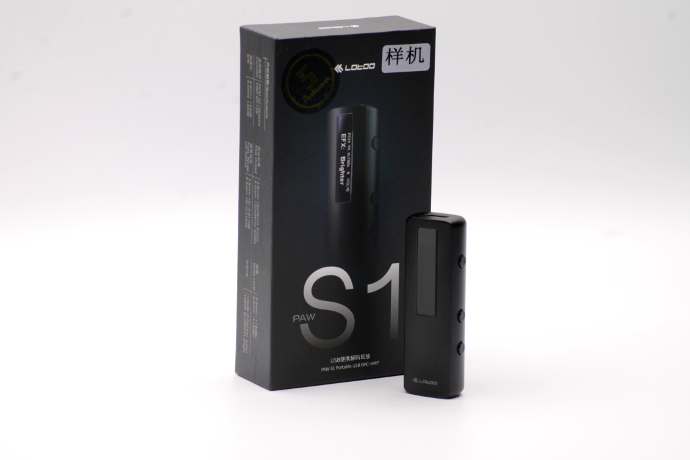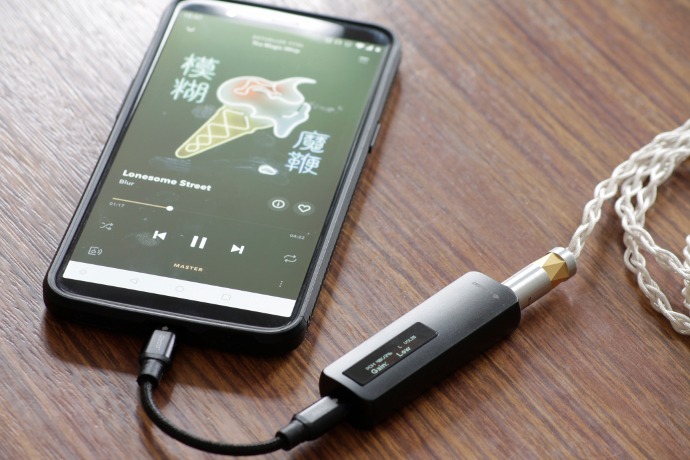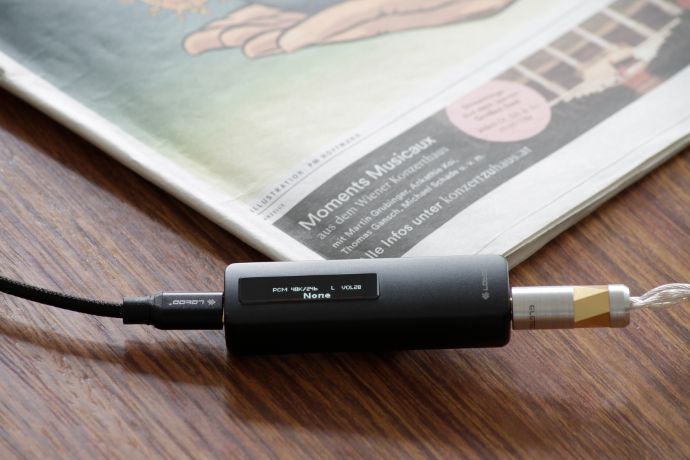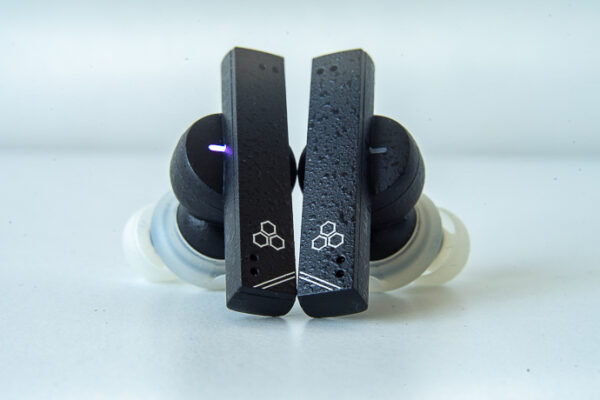Package:
[responsivevoice_button]
The package in which the PAW S1 comes in is very simple, yet leaves nothing to be desired. The box itself shows a photo of the S1 on front. In the box you will find a warranty card, a multi-lingual quick start guide and of course your new DAC/amp. Under the S1 you can find a USB C to USB C cable as well as a USB C to USB A adapter.
Apple users might want to look for a Lightning to USB C OTG cable. My sample actually came with one of those supplied, which I used with my iPad. The USB C to USB C cable measures 11.5 cm tip to tip and uses straight plugs.
Build Quality:
The PAW S1 is not bigger than your average USB stick. Its body is fully made out of aluminum, with the exception of the LCD screen on top. The S1 is anodized in black color and only very little is printed on it. On top you have Lotoo’s logo and on bottom there is a bit of information about it. You’ll also find a serial number sticker on bottom.
The body itself looks like it’s only two pieces, where the bottom has a plate screwed in place. The rest is a seamless piece. You can find three individual buttons on the S1. The “Fn” button lets you cycle through the menu of the PAW S1, where you can change EQ/ATE and gain settings. With the volume buttons + and – you can increase or decrease the loudness.
The USB socket is recessed into the body, but that’s no different to any other device I’ve seen so far. On the other side of the USB C socket you have the headphone outputs, which are flushed. Just like with my PAW 6000 these sockets are rather tight, so connecting and disconnecting your headphones will take slightly higher force.
Control:
Once you connected the PAW S1 to your phone or tablet it will boot up within seconds. You can activate the screen by pressing either of the three buttons. On the screen you get info on the decoded file and the volume setting you’re currently at. Left next to the volume setting you can also see if you’re using high (H) or low (L) gain. On the bottom of the screen the S1 informs you about the current EQ setting in use.
If you want to change the EQ setting you have to press “Fn” once and then cycle through the options using the +/- buttons. To change gain settings you have to press “Fn” twice and select high or low gain by pressing either + or -.
You can increase or decrease the volume setting by pressing the corresponding +/- button. The PAW S1 has a total of 100 volume steps to finely adjust the output level.
That’s it.

Lotoo PAW S1
To upgrade the firmware you have to download it from Lotoo’s website and connect the PAW S1 to your computer. Before you insert the USB cable to your computer make sure to press and hold down the “Fn” button. This will now enable you to get into the PAW S1’s internal memory. Paste the firmware file (.coe) in the root directory of the S1. Once the PAW S1 shows “Successful” on its display you can disconnect it.
A little side note: Although Lotoo publishes the firmware files for the S1 on their website, they also send out download links via their social media. These links are often much faster to download from than from Lotoo’s servers. So make sure to follow their social media channels to get the latest updates faster.
Sound:
The sound is always the most important aspect of any audio product in my opinion. I can look past build quality flaws if the sound is convincing me enough. I’ve been playing with the Lotoo PAW S1 for the better part of two months now, and during that time I used it with a multitude of different IEMs and headphones. I also switched transports to check if they have an affect on the sound – they don’t. What impacts sound however, is the quality of the files.
I noticed this when I was listening to Blur’s Magic Whip album through Tidal on my phone. Even though Tidal offers lossless streaming, my phone (OnePlus 5t) still resampled it internally before passing it on to the PAW S1.
The PAW S1 sounded a lot flatter and boring than when I listened to the same album through the Hiby Music app on the same phone. The music lost dynamics, body and basically everything that makes it enjoyable when listening with the Tidal app. For that reason alone I left Tidal out of the equation on my phone. I still used it as built-in streaming solution in Roon though.
Right from the start I was happy to find the PAW S1’s impressively low noise floor. With none of my monitors I could pick up any audible hissing. As a product that’s designed for use on the go, that’s probably one of the most important features to have.

Lotoo PAW S1
The PAW S1 has a relatively neutral to slightly warmish sound. It has great body and weight throughout its frequency spectrum and has wonderful technical abilities for its nature.
The bass on the S1 features good size and body, it reaches deep into the lows with neutral grunt and thunder. The PAW S1 does not put out a bassy sound at all. It has good texture and resolution in the lows and layers with excellence for its price. The bass and lower mids have a meatier character in total, but don’t come across as overly fat or saturated. It’s a nicely rich sound that comes with a presentation that stays clear of being dry.
The mids are relatively transparent, but with good body, smoothness and note size again. There is the same beautiful richness as in the lows to give a nicely organic sound. Instruments and singers sound realistic and have enough air in and around them to give you a feeling of openness. The resolution in the mid-range is quite good, the black background helps a lot in this case here. Instrumental separation is done very well with a clean cut, but I feel that the contrast between musicians and background could be even higher.
The PAW S1 creates a nicely spread sound-stage. It stretches in almost even dimensions into width and depth. It doesn’t sound very holographic, and keeps things happening closer to you. An aspect where the PAW S1 really surprised me is imaging and layering. For a device of that price and size it does it exemplary well. Pin pointing the musicians in the created room is rather easy with the PAW S1 for me. Of course, this also is heavily affected by the IEMs or headphones you use with it.
Treble has good extension and a fairly neutral tone. It doesn’t produce a harsh sound or fatiguing highs in my experience. The PAW S1 doesn’t give treble any brighter shimmer or glare, it keeps everything in a safely neutral position.
It goes on on page three!








Jack
How is the sound quality if compared to cheaper budget dongle priced under $100 like sonata HD pro or ibasso dc02/dc01?
Linus
Hi Jack,
thanks for your comment.
Unfortunately I don’t have any first hand experience with those. Sorry.
Cheers!
Vince
Thanks for the detailed view. It sounds a nice little device. Is it quiet enough to drive sensitive IEM like CA Solaris?
Linus
Hi Vince,
thanks for stopping by and leaving a comment.
The PAW S1 should not have any difficulties with the CA Solaris. Although I don’t have it, the S1 has no background noise with my hyper sensitive IEMs (Zeus XIV, Wraith). So I think you are in the clear. 🙂
Cheers!
VINCE
Thank you for the feedback. If the S1 can work with Zeus, I am sure this product can work with CA Solaris.
Jo
How does it compare with BTR5? They are similarly priced.
Can it match some desktop gear like a topping stack or a Zen Dac?
Robin
I have both. S1’s noise floor is low even for Solaris, which is great. However, volume 1 is even a little bit loud for me in a quiet room. It’s probably not a problem during commute. I just generally don’t pair Andromeda or Solaris with S1, cause I usually listen at home.
VINCE
Thanks Robin for your feedback. What DAP do you use with the Solaris? I am thinking about updating my AK 70 mark II.
Michael
Thanks a lot for reviewing. Would it be possible for you to make a comparison with iFi Hip DAC?
Eu Kit Kuan
Wow! Lotoo had always been the epitome of audio even it comes to DAP and I am sure this would be an epic device!
Si Grant
Balanced and single ended out’s, 2 gain settings and EQ from such a small footprint, now that is impressive ????
Aditya Sapre
Always wanted to try Lotoo products.. This seems like perfect product to start with.
Richard Whiddon
Did you try this S1 with your Dekoni Blue headphones? Can it drive these higher impedance phones to reasonable volume?
Thanks,
Richard
Martin
Dragonfly red – 2.1 V per channel for a power of approximately 2×135 mW into 32 Ohms no 69mW into 32 Ohms.
Tej
Hi there. I would be using this with a Oneplus 6 running Neutron. Does the S1 downsample e.g. from DSD256 to 128 or will it only play a track that is natively encoded as DSD128?
Matúš
A comparison between nextdrive spectra and Spectra X would be nice. And maybe that mentioned Cobalt as well :), Thanks.